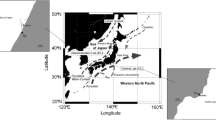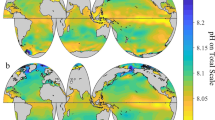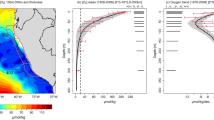Abstract
An international multi-disciplinary group of 24 researchers met to discuss ocean acidification (OA) during the Brazilian OA Network/Surface Ocean-Lower Atmosphere Study (BrOA/SOLAS) Workshop. Fifteen members of the BrOA Network (www.broa.furg.br) authored this review. The group concluded that identifying and evaluating the regional effects of OA is impossible without understanding the natural variability of seawater carbonate systems in marine ecosystems through a series of long-term observations. Here, we show that the western South Atlantic Ocean (WSAO) lacks appropriate observations for determining regional OA effects, including the effects of OA on key sensitive Brazilian ecosystems in this area. The impacts of OA likely affect marine life in coastal and oceanic ecosystems, with further social and economic consequences for Brazil and neighboring countries. Thus, we present (i) the diversity of coastal and open ocean ecosystems in the WSAO and emphasize their roles in the marine carbon cycle and biodiversity and their vulnerabilities to OA effects; (ii) ongoing observational, experimental, and modeling efforts that investigate OA in the WSAO; and (iii) highlights of the knowledge gaps, infrastructure deficiencies, and OA-related issues in the WSAO. Finally, this review outlines long-term actions that should be taken to manage marine ecosystems in this vast and unexplored ocean region.




Similar content being viewed by others
References
Abril G, Deborde J, Savoye N, Mathieu F, Moreira-Turcq P, Artigas F, Meziane T et al (2013) Export of 13C-depleted dissolved inorganic carbon from a tidal forest bordering the Amazon estuary. Estuar Coast Shelf S 129:23–27. doi:10.1016/j.ecss.2013.06.020
Abril G, Martinez J, Artigas LF, Moreira-Turcq P, Benedetti MF, Vidal L, Meziane T et al (2014) Amazon River carbon dioxide outgassing fuelled by wetlands. Nature 505:395–398. doi:10.1038/nature12797
Amado-Filho GM, Pereira-Filho GH (2012) Rhodolith beds in Brazil: a new potential habitat for marine bioprospection. Braz J Pharm 22(4):782–788
Amado-Filho GM, Moura RL, Bastos AC, Salgado LT, Sumida PY, Guth AZ, Francini-Filho RB et al (2012) Rhodolith beds are major CaCO3 bio-factories in the tropical South West Atlantic. PLoS One 7(4):e35171. doi:10.1371/journal.pone.0035171
Araujo M, Noriega C, Lefèvre N (2014) Nutrients and carbon fluxes in the estuaries of major rivers flowing into the tropical Atlantic. Front Mar Sci. doi:10.3389/fmars.2014.00010
Arruda R, Calil PHR, Bianchi AA, Doney SC, Gruber N, Lima I, Turi C (2015) Air–sea CO2 fluxes and the controls on ocean surface pCO2 variability in coastal and open-ocean southwestern Atlantic Ocean: a modeling study. Biogeosciences 12:5793–5809. doi:10.5194/bg-12-5793-2015
Barbera C, Bordehore C, Borg JA, Glémarec M, Grall J, Hall-Spencer JM, de la Huz C et al (2003) Conservation and management of northeast Atlantic and Mediterranean maerl beds. Aquat Conserv 13:865–876
Barton A, Waldbusser GG, Feely RA, Weisberg SB, Newton JA, Hales B, Cudd S, Eudeline B, Langdon CJ, Jefferds I et al (2015) Impacts of coastal acidification on the Pacific Northwest shellfish industry and adaptation strategies implemented in response. Oceanography 28(2):146–159. doi:10.5670/oceanog.2015.38
Bernardes M, Knoppers B, Rezende C, Souza W, Ovalle A (2012) Land-sea interface features of four estuaries on the South America Atlantic coast. Braz J Biol 72:761–774. doi:10.1590/S1519-69842012000400011
Bianchi AA, Bianucci L, Piola AR, Pino DR, Schloss I, Poisson A, Balestrini CF (2005) Vertical stratification and air-sea CO2 fluxes in the Patagonian shelf. J Geophys Res-Oceans 110:C07003
Bianchi AA, Pino DR, Perlender HGI, Osiroff AP, Segura V, Lutz V, Clara ML et al (2009) Annual balance and seasonal variability of sea-air CO2 fluxes in the Patagonia Sea: their relationship with fronts and chlorophyll distribution. J Geophys Res-Oceans 114:C03018. doi:10.1029/2008JC004854
Bosence D, Wilson J (2003) Maerl growth, carbonate production rates and accumulation rates in the northeast Atlantic. Aquat Conserv 13:821–831
Bourlès B, Lumpkin R, McPhaden MJ, Hernandez F, Nobre P, Campos E, Yu L et al (2008) The PIRATA Program: history, accomplishments, and future directions. B Am Meteorol Soc 89:1111–1125. doi:10.1175/2008BAMS2462.1
Boyd PW, Lennartz ST, Glover DM, Doney SC (2015) Biological ramifications of climate-change-mediated oceanic multi-stressors. Nat Clim Chang 5:71–79. doi:10.1038/nclimate2441
Camp EF, Krause S-L, Santos LMF, Naumann MS, Kikuchi RKP, Smith DJ, Wild C, Suggett DJ (2015) The “Flexi-Chamber”: a novel cost-effective in situ respirometry chamber for coral physiological measurements. PLoS One 10:e0138800. doi:10.1371/journal.pone.0138800
CBD, Secretariat of the Convention on Biological Diversity (2014) An updated synthesis of the impacts of ocean acidification on marine biodiversity. In: Hennige S, Roberts JM, Williamson P (ed) Montreal, Technical Series No. 75, p 99
Cesar H, Burke L, Pet-Soede L (2003) The economics of world-wide coral reef degradation. Cesar environmental economics consulting—WWF
Chen C-TA, Borges AV (2009) Reconciling opposing views on carbon cycling in the coastal ocean: continental shelves as sinks and near-shore ecosystems as sources of atmospheric CO2. Deep-Sea Res Pt II 56:578–590. doi:10.1016/j.dsr2.2009.01.001
Ciotti AM, Odebrecht C, Fillmann G, Möller OO (1995) Freshwater outflow and subtropical convergence influence on phytoplankton biomass on the southern Brazilian continental shelf. Cont Shelf Res 15:1737–1756. doi:10.1016/0278-4343(94)00091-Z
Cooley SR, Doney SC (2009) Anticipating ocean acidification’s economic consequences for commercial fisheries. Environ Res Lett 4:1–8
Cooley SR, Coles VJ, Subramaniam A, Yager PL (2007) Seasonal variations in the Amazon plume-related atmospheric carbon sink. Global Biogeochem Cycl 21:GB3014. doi:10.1029/2006GB002831
Cotovicz LC Jr, Knoppers BA, Brandini N, Costa Santos SJ, Abril G (2015) A large CO2 sink enhanced by eutrophication in a tropical coastal embayment (Guanabara Bay, Rio de Janeiro, Brazil). Biogeosci Discuss 12:4671–4720. doi:10.5194/bgd-12-4671-2015
Cruz ICS, Loiola M, Albuquerque T, Reis R, de Anchieta CC, Nunes J, Reimer JD, Mizuyama M et al (2015) Effect of phase shift from corals to zoantharia on reef fish assemblages. PLoS One 10:e0116944
da Cunha LC, Buitenhuis ET (2013) Riverine influence on the tropical Atlantic Ocean biogeochemistry. Biogeosciences 10(10):6357–6373. doi:10.5194/bg-10-6357-2013
da Silva Tiburcio ASX, Koening ML, de Macêdo SJ, de Castro Melo PAM (2011) A comunidade microfitoplanctônica do Arquipélago de São Pedro e São Paulo (Atlântico Norte-Equatorial): variação diurna e espacial. Biota Neotrop 11:203–215. doi:10.1590/S1676-06032011000200021
Dickson AG, Sabine CL, Christian JR (2007) Guide to best practices for ocean CO2 measurements. PICES Special Publication 3
Dominguez JML (2009) The coastal zone of Brazil. In: Dillenburg SR, Hesp PA (eds) Geology and geomorphology of holocene coastal barriers of Brazil. Springer, Berlin, pp 17–51
Doney SC, Balch WM, Fabry VJ, Feely RA (2009a) Ocean acidification: a critical emerging problem for the ocean sciences. Oceanography 22(4):16–25. doi:10.5670/oceanog.2009.93
Doney SC, Fabry VJ, Feely RA, Kleypas JA (2009b) Ocean acidification: the other CO2 problem. Ann Rev Mar Sci 1:169–192
Duarte G, Calderon EN, Pereira CM, Marangoni LFB, Santos HF, Peixoto RS, Bianchini A, Castro CB (2015) A novel marine mesocosm facility to study global warming, water quality, and ocean acidification. Ecol Evol. doi:10.1002/ece3.1670
Elfes CT, Longo C, Halpern BS, Hardy D, Scarborough C, Best BD, Pinheiro T et al (2014) A regional-scale ocean health index for Brazil. PLoS One 9(4):e92589. doi:10.1371/journal.pone.0092589
Fabricius KE, Langdon C, Uthicke S, Humphrey C, Noonan S, De’ath G, Okazaki R, Muehllehner N, Glas MS, Lough JM (2011) Losers and winners in coral reefs acclimatized to elevated carbon dioxide concentrations. Nat Clim Change 1:165–169
Ferreira BP, Maida M (2006) Monitoramento dos recifes de coral do Brasil (Série Biodiversidade), 18. MMA, Brasília, p 250
Ferreira BP, Costa MBSF, Coxey MS, Gaspar ALB, Veleda D, Araujo M (2012) The effects of sea surface temperature anomalies on oceanic coral reef systems in the southwestern tropical Atlantic. Coral Reefs 32:441–454
Frankignoulle M, Borges AV (2001) European continental shelf as a significant sink for atmospheric carbon dioxide. Global Biogeochem Cycle 15(3):569–576
Gruber N (1998) Anthropogenic CO2 in the Atlantic Ocean. Global Biogeochem Cycle 12:165–191
Gruber N, Hauri C, Lachkar Z, Loher D, Frölicher TL, Plattner GK (2012) Rapid progression of ocean acidification in the California Current System. Science 337(6091):220
Hatje V, Costa MF, da Cunha LC (2014) Oceanography and chemistry: bridging knowledge in favor of the oceans and society. Quim Nova 36(10):1497–1508
Hendriks IE, Duarte CM, Olsen YS, Steckbauer A, Ramajo L, Moore TS, Trotter JA et al (2015) Biological mechanisms supporting adaptation to ocean acidification in coastal ecosystems. Estuar Coast Shelf S 152:A1–A8
Horta PA, Vieira-Pinto T, Martins CD, Sissini MN, Ramlov F, Lhullier C, Scherner F, et al (2012) Evaluation of impacts of climate change and local stressors on the biotechnological potential of marine macroalgae: a brief theoretical discussion of likely scenarios. Rev Bras Farmacogn 22(4):768–774
Ibànhez JSP, Diverres D, Araujo M, Lefèvre N (2015) Seasonal and interannual variability of sea-air CO2 fluxes in the tropical Atlantic affected by the Amazon River plume. Global Biogeochem Cycles 30:1–40. doi:10.1002/2015GB005110
Ito RG (2014) Acidificação do Oceano Austral. In: Nastari A (ed) Antártica, 2048—Mudanças climáticas e equilíbrio global. MarinaBooks, São Paulo, pp 60–65
Ito R, Garcia CAE, Tavano VM. Net sea-air CO2 fluxes and modelled pCO2 in the southwestern subtropical Atlantic continental shelf during spring 2010 and summer 2011. Cont Shelf Res. (under review)
Ito RG, Schneider B, Thomas H (2005) Distribution of surface fCO2 and air-sea fluxes in the Southwestern subtropical Atlantic and adjacent continental shelf. J Marine Syst 56:227–242
Jiang LQ, Cai W-J, Wang Y, Bauer JE (2013) Influence of terrestrial inputs on continental shelf carbon dioxide. Biogeosciences 10:839–849
Johnson MD, Price NN, Smith JE (2014) Contrasting effects of ocean acidification on tropical fleshy and calcareous algae. Peer J 2:e411
Kerr R, da Cunha LC, Souza MFL, Perreti A (2012) First report of the Brazilian Ocean Acidification Research Group, Rio Grande, Brazil, BrOA Network. doi:10.13140/RG.2.1.2312.5202
Kerr R, da Cunha LC, Ito RG (2014) Second report of the Brazilian Ocean Acidification Research Group, Rio Grande, Brazil, BrOA Network. doi:10.13140/RG.2.1.2574.6643
Kikuchi RKP, Leão ZMAN, Oliveira MDM (2010) Conservation status and spatial patterns of AGRRA vitality indices in Southwestern Atlantic reefs. Rev Biol Trop 58(Suppl 1):1–31
Kleypas JA, Yates KK (2009) Coral reefs and ocean acidification. Oceanography 2:108–117
Koch M, Bowes G, Ross C, Zhang XH (2013) Climate change and ocean acidification effects on seagrasses and marine macroalgae. Global Change Biol 19:103–132
Kuffner IB, Andersson AJ, Jokiel PL, Rodgers KS, Mackenzie FT (2007) Decreased abundance of crustose coralline algae due to ocean acidification. Nat Geosci 1:114–117
Laborel JL (1969) Madreporaires et hydrocoralliaires recifaux des côtes brésiliennes. Systematique, ecologie, repartition verticale et geographie. Ann Inst Oceanogr Paris 47:171–229
Laruelle GG, Dürr HH, Lauerwald R, Hartmann J, Slomp CP, Goossens N, Regnier PAG (2013) Global multi-scale segmentation of continental and coastal waters from the watersheds to the continental margins. Hydrol Earth Syst Sci 17(5):2029–2051. doi:10.5194/hess-17-2029-2013
Laruelle GG, Lauerwald R, Pfeil B, Regnier P (2014) Regionalized global budget of the CO2 exchange at the air-water interface in continental shelf seas. Global Biogeochem Cycles. doi:10.1002/2014GB004832
Laruelle GG, Lauerwald R, Rotschi J, Raymond A, Hartmann J, Reginier P (2015) Seasonal response of air–water CO2 exchange along the land–ocean aquatic continuum of the northeast North American coast. Biogeosciences 12:1447–1458. doi:10.5194/bg-12-1447-2015
Leão ZMAN, Kikuchi RKP (2011) Brazil, coral reefs. In: Hopley D (ed) Encyclopedia of modern coral reefs. Springer, Netherlands, pp 168–172
Leão ZMAN, Kikuchi RKP, Testa V (2003) Corals and coral reefs of Brazil. In: Cortés JBT-LACR (ed) Latin American coral reefs. Elsevier Science, Amsterdam, pp 9–52
Leão ZMAN, Kikuchi RKP, Ferreira B, Neves EG, Sovierzoski HH, Oliveira MDM, Maida M et al (2015) Brazilian coral reefs in a time of global changes: a synthesis. Braz J Oceanogr
Lefèvre N, Urbano DF, Diverrès D, Francis G (2014) Impact of physical processes on the seasonal distribution of the fugacity of CO2 in the western tropical Atlantic. J Geophys Res Oceans 119(2):646–663. doi:10.1002/2013JC009248
Lencina-Avila JM, Ito R, Garcia CAE, Tavano VM. Sea-air carbon dioxide fluxes along 35°s in the Atlantic Ocean and adjacent continental shelves. Deep Sea Res I. (under review)
Loiola M, Oliveira MDM, Kikuchi RKP (2013) Tolerance of Brazilian brain coral Mussismilia braziliensis to sediment and organic matter inputs. Mar Pollut Bull 77:55–62
Mathis JT, Feely RA (2013) Building an integrated coastal ocean acidification monitoring network in the U.S. Elem. Sci. Anthr. 1:000007. doi:10.12952/journal.elementa.000007
McCoy SJ, Kamenos NS (2015) Coralline algae (Rhodophyta) in a changing world: integrating ecological, physiological, and geochemical responses to global change. J Phycol 51:6–24
Meybeck M, Ragu A (2012) GEMS-GLORI world river discharge database. doi:10.1594/PANGAEA.804574
Möller OO, Piola AR, Freitas AC, Campos EJD (2008) The effects of river discharge and seasonal winds on the shelf off southeastern South America. Cont Shelf Res 28:1607–1624. doi:10.1016/j.csr.2008.03.012
Moser GAO, Takanohashi RA, de Chagas Braz M et al (2014) Phytoplankton spatial distribution on the Continental Shelf off Rio de Janeiro, from Paraíba do Sul River to Cabo Frio. Hydrobiologia 728:1–21. doi:10.1007/s10750-013-1791-3
MPA—Ministério da Pesca e Aquicultura (2011) Boletim Estatístico da Pesca e Aquicultura 2011. Brasilia, p 60
MPA—Ministério da Pesca e Aquicultura (2012). Boletim Estatístico da Pesca e Aquicultura-Brasil 2010. Brasilia, p 128
Newton JA, Feely RA, Jewett EB, Williamson P, Mathis J (2014) Global ocean acidification observing network: requirements and governance plan. www.goa-on.org
Nixon SW (1995) Coastal marine eutrophication: a definition, social causes, and future concern. Ophelia 41:199–219
Noriega CED, Araujo M (2014) Carbon dioxide emissions from estuaries of northern and northeastern Brazil. Sci Rep 4:6164. doi:10.1038/srep06164
Noriega CED, Araujo M, Lefèvre N (2013) Spatial and temporal variability of the CO2 fluxes in a tropical, highly urbanized estuary. Estuar Coast 36:1–18
Noriega CED, Araujo M, Lefèvre N, Montes MF, Gaspar F, Veleda D (2015) Spatial and temporal variability of CO2 fluxes in tropical estuarine systems near areas of high population density in Brazil. Reg Environ Change 15:619–630
Oliveira MDM (2008) Decline of Calcification Rates of the endemic coral Mussismilia braziliensis: thermal stress alerts in Brazil. In: Wilkinson C (ed) Status of coral reefs of the world: 2008, 1. Australian Institute of Marine Science, Cape Ferguson, Queensland
Ovalle ARC, Rezende CE, Lacerda LD, Silva CAR (1990) Factors affecting the hydrochemistry of a mangrove tidal creek, Sepetiba Bay, Brazil. Estuar Coast Shelf Sci 31:639–650. doi:10.1016/0272-7714(90)90017-L
Padin XA, Vázquez-Rodríguez M, Castañol M, Velo A, Alonso-Pérez F, Gago J, Gilcoto M et al (2010) Air-sea CO2 fluxes in the Atlantic as measured during boreal spring and autumn. Biogeosciences 7:1587–1606
Pereira AF, Belém AL, Castro BM, Geremias R (2005) Tide-topography interaction along the eastern Brazilian shelf. Cont Shelf Res 25(12–13):1521–1539. doi:10.1016/j.csr.2005.04.008
Pereira-Filho GH, Amado-Filho GM, de Moura RL, Bastos AC, Guimarães SMPB, Salgado LT, Francini-Filho RB et al (2012) Extensive Rhodolith Beds Cover the Summits of Southwestern Atlantic Ocean Seamounts. J Coastal Res 279(1):261–269. doi:10.2112/11T-00007.1
Riebesell U, Fabry VJ, Hansson L, Gattuso J-P (2010) Guide to best practices for ocean acidification research and data reporting, 260 p. Publications Office of the European Union, Luxembourg
Ríos AF, Velo A, Pardo PC, Hoppema M, Pérez FF (2012) An update of anthropogenic CO2 storage rates in the western South Atlantic basin and the role of Antarctic Bottom Water. J Mar Syst 94:197–203. doi:10.1016/j.jmarsys.2011.11.023
Rocha CB, da Silveira ICA, Castro BM, Lima JAM (2014) Vertical structure, energetics, and dynamics of the Brazil Current System at 22°S-28°S. J Geophys Res-Oceans 119:52–69. doi:10.1002/2013JC009143
Salt LA, van Heuven SMAC, Claus ME, Jones EM, de Baar HJW (2015) Rapid acidification of mode and intermediate waters in the southwestern Atlantic Ocean. Biogeosciences 12:1387–1401. doi:10.5194/bg-12-1387-2015
Sarmento VC, Souza TP, Esteves AM, Santos PJP (2015) Effects of seawater acidification on a coral reef meiofauna community. Coral Reefs. doi:10.1007/s00338-015-1299-6
Silva AS, Leão ZMAN, Kikuchi RKP, Costa AB, Souza JRB (2013) Sedimentation in the coastal reefs of Abrolhos over the last decades. Cont Shelf Res 70:159–167
Souza MFL, Gomes VR, Freitas SS et al (2009) Net ecosystem metabolism and nonconservative fluxes of organic matter in a tropical mangrove estuary, Piauí River (NE of Brazil). Estuar Coasts 32:111–122. doi:10.1007/s12237-008-9104-1
Steller DL, Riosmena-Rodriguez R, Foster MS, Roberts CA (2003) Rhodolith bed diversity in the Gulf of California: the importance of rhodolith structure and consequences of disturbance. Aquat Conserv 13:S5–S20
Summerhayes CP, Coutinho PN, França AMC, Ellis JP (1975) Part III. Salvador to Fortaleza, Northeastern Brazil. In: Milliman JD, Summerhayes CP (eds) Upper continental margin sedimentation off Brazil. E. Schweizerbartsche Verlarsbuchhandlung, Sttutgart, pp 44–78
Susini-Ribeiro SMM (1999) Biomass distribution of pico-, nano- and microplankton on the continental shelf of Abrolhos, East Brazil. Arch Fish Mar Res 47:271–284
Tabarelli M, da Rocha CFD, Romanowski HP, Rocha O, de Lacerda LD (2013) PELD—CNPq: dez anos do Programa de Pesquisas Ecológicas de Longa Duração do Brasil: achados, lições e perspectivas. Editora Universitária da UFPE, Recife. http://www.cnpq.br/documents/10157/a3c85e89-83bb-4eac-8de3-0c0842550abe
Tsunogai S, Watanabe S, Sato T (1999) Is there a “continental shelf pump” for the absorption of atmospheric CO2? Tellus B 51:701–712
Turra A, Cróquer A, Carranza A, Mansilla A, Areces AJ, Werlinger C, Martínez-Bayón C et al (2013) Global environmental changes: setting priorities for Latin American coastal habitats. Glob Change Biol 19:1965–1969. doi:10.1111/gcb.12186
Wallace RB, Baumann H, Grear JS, Aller RC, Gobler CJ (2014) Coastal ocean acidification: the other eutrophication problem. Estuar Coastal Shelf S 148:1–13
Acknowledgments
This review contributes to the activities of the BrOA Network (funded by CNPq Nos. 481670/2010-6, 485967/2012-0, 311877/2013-3, 405585/2013-6, 482557/2013-3, 445506/2014-8; FAPERGS No. 2075-2551/13-7; FAPESP No. 2014/22273-1; CAPES No. 23038.001421/2014-30 and scholarships, Fundação Boticário de Proteção a Natureza No. 0956-20122) and resulted from Joint BrOA-SOLAS Workshop discussions that were held in Santos (March 21–22, 2015) as part of the Third International Symposium on the Effects of Climate Change on the World’s Oceans. We thank all 24 participants who collaborated during that period, particularly Arne Körtzinger, Cristian Vargas, David Osborn, Jean-Pierre Gattuso, Kirsten Isensee, and Silvana Birchenough, who provided considerable input. We also thank the supporters of the BrOA Network’s formation, including Andrew Dickson, Christopher Langdon, Ilana Wainer, Joan Kleypas, Lisa Robbins, and Libby Jewett, who encouraged and collaborated with us during the initial implementation of the network. R.K.P.K. and P.A.H. also thank CNPq fellowship grants.
Author information
Authors and Affiliations
Corresponding author
Electronic supplementary material
Below is the link to the electronic supplementary material.
Rights and permissions
About this article
Cite this article
Kerr, R., da Cunha, L.C., Kikuchi, R.K.P. et al. The Western South Atlantic Ocean in a High-CO2 World: Current Measurement Capabilities and Perspectives. Environmental Management 57, 740–752 (2016). https://doi.org/10.1007/s00267-015-0630-x
Received:
Accepted:
Published:
Issue Date:
DOI: https://doi.org/10.1007/s00267-015-0630-x




